
Exploring Grant Grove in Kings Canyon National Park
“It’s so incredibly massive!” I said, awe-struck, and aloud to a small group of strangers. That was my initial reaction when I first saw the General Grant Tree. The impressive sequoia is in Kings Canyon National Park in California’s Sierra Nevada Mountains. The trailhead is located in the Grant Grove area of the park, which is only about an hour and fifteen minutes from Fresno.
We got there before sunrise on an early summer weekday morning. Surprisingly, we were not the first car in the parking lot. It was a cool morning, but the forecast called for highs in the 90s, so I was stoked to be there early. The sun was not quite up, so we made coffee and had a snack. The parking lot is not huge by any means but has quite a few spaces and is surrounded by giant sequoias. I asked a Park Ranger who was emptying trash cans how busy it gets. “It will be completely full in a few hours,” he said. The sun was starting to warm the sky, so I said goodbye, and the wife and I hit the trail.
Hiking the General Grant Grove
The hike is easy and only about three-fourths of a mile loop. But there is an impressive amount to see in that short distance. Most information says it takes about 15 to 20 minutes to hike. I planned on doubling that because the scenery and history are amazing. Here’s what to expect: the General Grant Tree is clearly the highlight and is about halfway around the loop. But there are more; along the way, you will pass the Robert E. Lee Tree, Fallen Monarch, Tennessee Tree, the historic Gamlin Cabin, and Centennial Stump.
We headed to the right from the trailhead and were immediately greeted by a group of deer that did not seem to care about us. Clearly, they were more concerned with breakfast. Right after the deer, we came to our first insanely large sequoia.

Robert E. Lee Tree in Grant Grove
The Robert E. Lee Tree is the tenth-largest giant sequoia in the world, with a height of more than 250 feet. It’s named after Confederate General Robert E. Lee. The National Park Service removed references to the name along the trail and in park materials, but it’s easy to figure out which tree it is as it stands directly next to the bottom of Fallen Monarch.
Fallen Monarch
This dead sequoia has been hollowed out by fire. It’s estimated it fell about 300 years ago. Israel and Thomas Gamblin, as well as other park visitors, used the tree for shelter. Today, you can walk through the tree and see why. It makes a great shelter from the elements. It was also used as a stable by the U.S. Calvary. Make sure to check out the park sign next to the top. The photo from 1900 shows just how little things have changed in more than 100 years.
We continued up the trail until we got to a bend in the trail that offered a fantastic top-to-bottom view of the General Grant Tree. After enjoying the view for a bit, we came to another bend in the trail, which is home to the Tennessee Tree. This impressive sequoia is about 234 feet tall and has been slightly hollowed out by fire. A short distance to the left is the star of the trail. As we approached, I muttered to my wife, “This is the biggest thing I have ever seen.” “It’s so big it barely looks real,” she replied. The spectacular view was made even better by the deep, dark blue sky without a cloud in sight.

The General Grant Tree
The General Grant Tree is the second-largest tree in the world. (Some argue that the President Tree in Sequoia National Park’s Giant Forest is larger. This is debated.) It soars 268 feet, is 104 feet around, and is 40 feet wide. I can say with absolute certainty that this is one of those times when pictures did not do justice to the size of the tree. At an estimated 1,700 years, it’s not nearly the oldest sequoia. It’s about 1,500 years younger than the oldest sequoia. The General Tree is thought to have grown so fast because it is located in ideal conditions with plenty of sun and ample water. In October 1879, Ulysses S. Grant visited the tree during his world tour following his term as President of the United States.
“Your favor of the 5th of September, by Express, accompanying a box containing branches &c. from the largest tree in California, and no doubt in the world, which too partial friends have done me the honor to name after me, is at hand. Please accept my thanks for thus remembering me and also for the kind expressions of regard contained in your letter.” – Grant upon learning that the tree was named after him
General Grant Statistics
- Volume: 46,608 cubic feet
- Height: 268 feet
- Age: 1,700 years old (estimated)
- Weight: 1,254 tons (estimated)
- Circumference: 104 feet (at its base)
- Diameter: 40 feet
The General Grant Tree is also the nation’s Christmas tree, not to be confused with the National Christmas Tree, which is decorated in Washington. D.C. each year. How it became the Nation’s Christmas Tree is a fun story. Back in 1924, a man from Sanger, California, was visiting Grant’s Grove with his family. As they stared in wonder at the General Grant Tree, a little girl looked up at her father and said, “What a lovely Christmas tree that would be.” The idea took off from there with the local chamber of commerce lobbying for the Nation’s Christmas Tree. In 1926, President Calvin Coolidge officially designated the General Grant tree as the “Nation’s Christmas Tree.”
Nation’s Christmas Tree
The tree also holds another distinguished honor. 30 years after it became the Nation’s Christmas Tree, in 1956 President Dwight Eisenhower elevated its status by designating it our nation’s only living National Shrine. This was done to “provide further recognition of the Nation’s Christmas Tree as a living symbol of our American Heritage…in memory of the men and women of the Armed Forces who have served and fought and died to keep this Nation free…” Since 1925, every Christmas, a wreath has been laid at the base of the General Grant Tree to honor those who have served in the armed forces.
We stood there by ourselves for quite a while, taking it all in and snapping a few photos. We walked around the tree and took a short spur trail to the Vermont Log, another fallen sequoia. Eventually, we found ourselves back in front. A few families arrived, and I took pictures of them posing in front of the tree. They politely returned the favor for the Mrs. and me.

Gamlin Cabin in Grant Grove
Continuing down the trail, we came to the historic Gamlin Cabin, built in 1871 by brothers Israel and Thomas Gamlin. The two filed a timber claim to 160 acres in the grove and grazed cattle in the mountains. After President Benjamin Harrison signed a bill establishing General Grant National Park (now part of Kings Canyon National Park), the cabin was used by the U.S. Cavalry, who patrolled the park until 1913. Later, it would house the first park ranger stationed here.
Centennial Stump in Grant Grove
After passing the Gamlin Cabin, we quickly came upon the Centennial Stump. The tree was downed in 1875 to convince Easterners that such giant trees existed. Two men took nine days to cut it down. A 16-foot section was sent to the World’s Fair in Philadelphia in 1876, where it became known as a “California Hoax” by skeptical Easterners.
More than an hour into a short hike, we headed back to the car. Passing the top of Fallen Monarch along the way
If Kings Canyon and Sequoia National Parks are on your list, explore Grant Grove.
Other Ulysses S. Grant Historic Sites to Visit
Ulysses S. Grant National Historic Site near St. Louis, Missouri.












